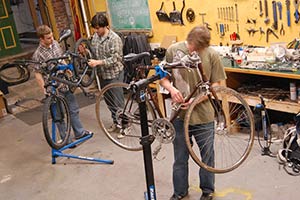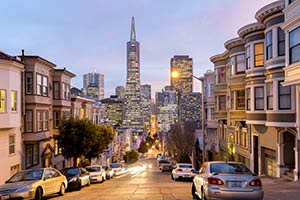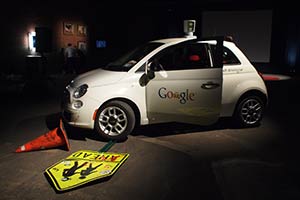
Dear EarthTalk: What kinds of changes to federal environmental policies can we expect to see from Donald Trump when he assumes the presidency? — D. Shelley, Bounder, CO
Like many Americans, environmental advocates are alarmed at the results of the 2016 election. What worries them most is Trump’s call for reneging on the landmark Paris climate accord, which secured commitments from the world’s largest polluters to scale back emissions. The agreement just went into force and the U.S. is committed to it for four years, but Trump insiders report The Donald may try to submit the agreement for ratification by an unsympathetic Senate (Obama has maintained ratification isn’t necessary) in efforts to derail U.S. participation.
“If Trump yanks the United States out of the Paris agreement, the deal won’t die, but momentum could wane,” reports Brad Plumer on Vox.com. “One can imagine China and India deciding they don’t need to push nearly as hard on clean energy if the world’s richest and most powerful country doesn’t care. At best, progress would slow. At worst, the entire arrangement could collapse, and we would set out on a path for 4°C warming or more.”
Another sore spot for environmentalists is Trump’s attitude toward the Environmental Protection Agency (EPA). Initially Trump said he would disband the agency, but more recently said he would keep it in a stripped down form refocused on its “core mission of ensuring clean air, and clean, safe drinking water for all Americans.” Myron Ebell, a leading climate skeptic with the Competitive Enterprise Institute and no friend to the environmental community, is slated to run the new leaner EPA.
Meanwhile, proponents of pipelines to move petroleum products from the great gas and oil fields of the northern U.S. and Canada are overjoyed at the Republican sweep of Election 2016. Given Trump’s stated goals of reducing the federal government’s role in energy and environmental policy while encouraging more infrastructure projects to connect production with markets and consumers, environmentalists are bracing for a revival of the much-disputed Keystone XL pipeline project that President Obama rejected last year. There are fears, as well, of a green light for the Dakota Access Pipeline project, currently in a holding pattern as native and environmental protestors stage a civil disobedience camp-out nearby. Not surprisingly, shares in the two companies behind the respective projects rallied following the election.
For their part, environmentalists are already starting to refocus on what they can do without the support of the White House. “Under President George W. Bush, the environmental community took the battle to the courts and Congress and watch-dogged political appointees; we blocked attacks on the environment; we galvanized the public to take action,” says Kate Colwell, an activist with the non-profit Friends of the Earth. “After the more recent fights to kill the Keystone XL pipeline, ban fracking and shut down coal plants, the environmental movement is stronger than we have ever been.”
“We will have to harness our new energy, join together, and use every strategy possible to fight against hate and greed and environmental destruction,” she adds. “While I wish we had a different fight before us, we must fight the one presented to us. The future of our country and planet depends on it.”
Contacts: Vox, www.vox.com; Friends of the Earth, www.foe.org. Photo above: President-elect Donald Trump is planning to tap a leading climate change denier to lead a streamlined Environmental Protection Agency while finding a way to get the U.S. out of its emissions reduction commitments made by the Obama administration under the Paris climate accord. Credit: Gage Skidmore, FlickrCC.

In recent years, colleges and universities have recognized the capacity for their independent communities to lead the nation as examples of sustainable and carbon-neutral institutions. Colleges in the U.S. and around the world have introduced conservation measures to reduce waste, installed solar panels to reduce reliance on fossil fuels, and promoted shared vehicles to reduce carbon emissions, among other initiatives.
Many colleges have followed the lead of Stanford University’s “Green Campus” program by replacing disposable plastic utensils with organic alternatives. Cutlery made from potato starch and sugarcane allows students to simply put all waste in compost bins, including the utensils themselves. This compost is reintroduced, in turn, as fertilizer for use on university gardens.
Reusable mug programs accomplish similar goals. At Portland Community College in Oregon, bringing your own mug gets you a 5-cent discount per drink, while other colleges with meal plans offer similar incentive programs. And efforts to reduce waste aren’t limited to the dining hall. The University of Illinois Urbana-Champaign and Purdue University have partnered with Kimberly-Clark Professional’s RightCycle program to recycle non-hazardous lab waste. Since joining the program in 2013, the colleges have redirected six tons of plastic waste from landfills for use as shelving, flowerpots and furniture.
Meanwhile, 48 different colleges-from Harvard to UC Santa Cruz-have signed on with the Post-Landfill Action Network (PLAN), which helps universities reduce waste through plastic-free initiatives, waste audits and move-in/move-out collections and subsequent sales.
Universities can also employ renewable energies to offset power demands from fossil fuels. Campus solar installations have risen dramatically in the past decade. Large, tall structures — the style of many academic buildings — are ideal locations for photovoltaic panels, especially as peak electrical production correlates with peak demand during daytime hours. And photovoltaic installations are not limited to sunny states; Colby College completed a 1.9 megawatt project in 2015 that is currently the largest system in Maine.
Other forms of renewable energy have also seen tremendous success on college campuses. A University of New Hampshire project provides over 80 percent of its energy using landfill gas. And Ball State University in Muncie, Indiana has replaced its outdated coal boilers with 3,750 geothermal wells that utilize the Earth’s interior temperature to regulate heat in campus buildings.
Colleges have also taken steps to green up transportation. Vermont’s Middlebury College introduced its Yellow Bikes Cooperative in 2001 to offer public bicycles to students for just $6 per year. And students there who complete a free class on bicycle repair are rewarded with a free discarded bike. Many colleges also now partner with Zipcar to offer student rates, reducing the need for personal vehicles on campus. And dozens of colleges nationwide have replaced campus car and bus fleets with electric vehicles.
These are just a few examples of how higher education is walking the talk on the environment. If your school isn’t already moving in the same direction, there’s no time like the present to team up with students, faculty and administrators to initiate Earth-friendly policies and encourage greener behaviors.
Contacts: Sustainable Stanford, sustainable.stanford.edu; Post-Landfill Action Network, www.postlandfill.org; RightCycle, www.kcprofessional.com/brands/kimtech/rightcycle.

It’s true that we waste lots of gas and time — and create lots of stress for ourselves — in the constant search for parking spaces. UCLA urban planning professor Donald Shoup and his students observed hundreds of cars driving around four sites in Los Angeles’s bustling Westwood Village, a commercial district next to the UCLA campus, and found about one in three drivers was “cruising” in search of a spot. On average, each cruising driver spent only 3.3 minutes on the hunt over about a half-mile distance, but the numbers add up quickly, given that some 8,000 cars park in Westwood Village each day.
“Over a year, cruising in Westwood Village creates 950,000 excess VMT [vehicle miles traveled] — equivalent to 38 trips around the Earth, or four trips to the moon,” says Shoup. This excess mileage in just one small business district waste some 47,000 gallons of gasoline while producing 730 tons of CO2 emissions annually. Shoup thinks crowded metro areas should increase the price of street parking to make it cost as much or more than commercial or private parking garages so as to discourage all this wasteful cruising and force drivers into dedicated parking facilities where they won’t slow down other motorists.
Luckily there’s a slew of new services that make it easier than ever to park responsibly. BestParking, Parking Panda, Parker, ParkWhiz and ParkMe each provide users with access to hundreds of garages and lots in major cities across the U.S. through easy-to-use Smartphone interfaces. SpotHero works on a similar model, but also offers up its own dedicated discounted spots in select parking facilities.
Meanwhile, SpotOn Parking is using San Francisco as a testing ground for its new service connecting drivers with property owners looking to monetize under-utilized parking spots. Users of the free SpotOn app can search for available spaces nearby-and reserve and pay with the click of a virtual button.
Of course, another way to reduce the need to park is to embrace public transit and ridesharing. If you ride the bus or train — or walk or bike — you won’t have to waste time or fuel looking to park. Another way to avoid parking hassles is by using Uber or Lyft, or by joining a car-share service like Zipcar which provides dedicated parking spots all around town for its vehicles.
At the meta level, American cities could follow the lead of some of their forward-thinking European counterparts like Antwerp and Zurich, which have significantly reduced the overall number of (private and public) parking spaces available, in turn leading to a measurable downturn in vehicle miles travelled within city limits. If people have nowhere to park, they won’t bother driving their own cars into the city.
While encouraging people to use public transit, car sharing or at least parking apps is a step in the right direction, policy changes that reduce the number of spots altogether might be our best bet in reducing gas consumption, carbon emissions and the waste of time we all experience hunting for that next parking spot.
Contacts: BestParking, www.bestparking.com; ParkWhiz, www.parkwhiz.com; Parker, www.theparkerapp.com; Panda Parking, www.parkingpanda.com; ParkMe, www.parkme.com; SpotHero, www.spothero.com; SpotOn Parking, www.spotonparking.com; “Europe’s Parking U-Turn: From Accommodation to Regulation,” www.itdp.org/europes-parking-u-turn-from-accommodation-to-regulation/; Donald Shoup’s “Cruising for Parking,” http://shoup.bol.ucla.edu/CruisingForParkingAccess.pdf.

You know the future is here when you see that the car beside you at a red light has nobody at the helm. That’s already happening in California where a few companies (Uber, Google, Apple, Tesla) have begun testing autonomous vehicles on the open road — albeit with human drivers at the ready in case anything goes wrong. Meanwhile, the major automakers have begun integrating autonomous driving technologies (blind spot detection, GPS mapping, assisted parking, etc.) into existing models, and will surely offer their own fully self-driving cars once lawmakers qualify them as street legal, maybe as early as 2018.
Proponents say that not only will driverless cars make our roads safer (as they can sense walkers, bikers, other cars and road infrastructure to avoid collisions), but will also be a boon to the environment. Zia Wadud, who co-authored a study released earlier this year assessing the travel, energy and carbon impacts of autonomous vehicles, says the widespread adoption of the technology could reduce energy consumption significantly.
“Automated vehicles can interact with each other and drive very closely as a ‘platoon,'” reports Wadud. “This can reduce the total energy consumption of road transport by 4 percent to 25 percent, because vehicles which follow closely behind each other face less air resistance.” Beyond the platoon benefit, driverless cars can also shave another 25 percent off overall automotive energy consumption through more efficient computer-assisted ride optimization.
Yet another environmental benefit could be fewer cars on the road altogether. “Your car could give you a lift to work in the morning and then give a lift to someone else in your family — or, for that matter, to anyone else: After delivering you to your destination, it doesn’t sit idle in a parking lot for 20-plus hours every day,” report MIT researchers Matthew Claudel and Carlo Ratti in a recent McKinsey.com article. “By combining ride sharing with car sharing…it would be possible to take every passenger to his or her destination at the time they need to be there, with 80 percent fewer cars.” They conclude that clearing four of five cars from the road would have “momentous consequences” for our cities regarding pollution, traffic, efficiency, and parking.
But Jason Bordoff of Columbia University’s Center on Global Energy Policy argues in The Wall Street Journal that driverless cars hurt overall energy efficiency by undermining public transit: “If you can work, watch a movie or sleep while in the car, perhaps you will take a car rather than public transportation or be more likely to drive for long trips.” He adds that autonomous vehicles also “significantly expand the universe of potential drivers” bringing more people (and cars) onto the road and possibly increasing total vehicle miles travelled overall. “Even car-sharing services could increase energy demand if the ease and convenience pulls people away from mass transit, walking or biking and into cars.”
Bordoff remains optimistic that autonomous vehicles can provide a net gain for society and the environment, but only if we are careful about how we implement the technology. “To ensure that autonomous vehicles deliver economic, energy security and environmental benefits, we will need supporting policies targeted at those objectives, such as increased fuel-economy standards, investments in public transportation infrastructure, and R&D in alternative vehicle technologies.”
Contacts: “Help or hindrance? The travel, energy and carbon impacts of highly automated vehicles,” www.sciencedirect.com/science/article/pii/S0965856415002694; Claudel and Ratti’s “Full Speed Ahead: How the Driverless Car Can Transform Cities,” www.mckinsey.com/business-functions/sustainability-and-resource-productivity/our-insights/full-speed-ahead-how-the-driverless-car-could-transform-cities; Columbia Center on Global Energy Policy, energypolicy.columbia.edu.









